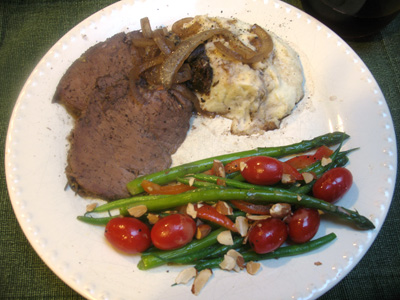“fond” of chowder
Connor is home this weekend from NAU and requested Clam Chowder for dinner tonight. OK, the high today is supposed to be 87 degrees, but if my boy wants chowder, chowder it will be!
Traditionally, bacon is used to start the chowder, but I have a boatload of pancetta in my freezer, so I will begin with that. Once the pancetta has rendered its fat and is crisp, most of the fat is discarded, and only 1 tablespoon will be used to sear the scallops. The scallops are removed and what remains in the pan is called the “fond”. In French, fond means “base”. Fond refers to the browned and caramelized bits of meat or vegetables stuck to the bottom of a pan after sautéing. Traditional cookware is best for developing a decent fond. Non-stick coatings tend to inhibit its development. After the meat is browned, it is removed from the pan and excess fat is discarded. Generally, aromatics such as onion, garlic, or shallots are sautéed, then a liquid such as stock, alcohol, fruit juice, or even water (or as world-famous Chef Jacques Pépin calls it ” l’eau du sink “) is used to deglaze the pan and loosen the fond from the pan to become “one” with the dish. The fond is the base for a great sauce, or in this case, a great chowder. Since I mentioned Jacques Pépin, I’m adding one of my favorite pictures of the two of us at the end of this post, as a bonus.
Sherry being added to the fond, deglazing the pan
October 24, 2009 2 Comments
lots of pancetta plus a little pork
I was at Costco the other day (what’s new?) and was shopping for the “Tucson Roommate Dinner” when I spotted a new item – a huge roll of pancetta. It was just too gorgeous and I couldn’t resist. Now I have to think of dishes to make with my 2 pounds! Pancetta is an Italian bacon that is cured with salt, pepper, and other spices. It is dried for about three months but is not usually smoked. It comes from the pork belly only instead of the sides and belly of the pig, as American bacon does. It is sold in either thin slices or in a roll. Each region of Italy produces its own type of pancetta and in Corsica, it is considered a regional flavor. Since I really don’t want to have pancetta for dinner every night for two weeks, I will be freezing the excess. To do so, I will cut it into 1/2-inch pieces (each about 4 ounces) wrap each tightly in plastic wrap, then in foil, place all pieces in a freezer zip-lock; label with the contents and date, and freeze.
This recipe is pork with more pork. Pork tenderloin with little bits of pancetta inserted inside. The silver skin needs to be removed from the tenderloin, if you need instruction, please see the Tip Index under pages, to the left. The sauce uses a reduced beef broth. Be careful when reducing the broth. It seems to take a long time at first, but once it is reduced by half, the next reduction of half again goes quickly. When reducing a liquid like this, keep a glass measuring cup next to the stove and when you think you’re getting close to the correct amount, just pour the liquid from the pan into the measuring cup. Keep checking every couple of minutes near the end so you don’t go too far. If you happen to reduce it too much, just add water to correct it.
[Read more →]
September 26, 2009 No Comments
lil’ chef in the making and pomegranate-chipotle pork tenderloin

Me at 2 years old
I finally took on a task that I’d been putting off for months… OK, not months, years! Scanning pictures that are “pre-digital” onto my computer. See, this is what happens when your kids leave you for college – you do things! I found this picture in the stack and just couldn’t resist posting it. I am two years old here, according to my mom’s writing on the back. With an apron on! Wow, who knew?
Today’s tip has to do with fresh ginger root. It is something I don’t always have on hand but not something I’m willing to go to the store for if it’s the only thing I need. So I always buy a bit bigger piece than I’ll need, I peel the extra and slice it into “coins” about 1/2-inch thick. I have a jar in my fridge that I keep the ginger coins in that is filled with Sherry. That way whenever you need fresh ginger and don’t have it in the produce drawer, just pull out a coin or two, mince it up and you’re ready to go!
When working with pork tenderloin, you must always trim away the silver skin. Silver skin is a layer of white connective tissue or membrane that you find on pork tenderloin and a variety of other tender meats. It is tough as rubber and needs to be removed before cooking. It is not difficult to do; cut it off in then strips, angling a sharp paring knife against the membrane, not the meat, then slide your knife along the silver skin, pulling back tightly on it, and continue to do so until the loin is clean. See the picture below.
[Read more →]
September 1, 2009 9 Comments
sunday roast and birthday wishes

This recipe was last night’s dinner, served with sides of roasted garlic mashed potatoes and blanched asparagus and green beans (leftover crudites from the NCL Saturday class) that were heated and dressed with the same Garlic Parmesan Crema used to season the roast. Most Sundays my dad comes over and we play cards (Spades, Hearts, Gin Rummy, and/or Pinochle before dinner, and the meals are usually standard meat/potatoes. But honestly, you can’t beat an inexpensive beef roast on the weekend. Today is my dear friend’s, Larry Fitzgerald, birthday – he is a mere 26 years old today. We’ve been in the kitchen together since he was 22 and he is an excellent cook and an amazing person. Happy Birthday, Fitz!
August 31, 2009 2 Comments




